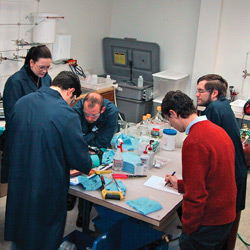Powering Electric Vehicles

With the recent focus on cutting-edge, green energy solutions, coupled with the evolution of the automotive industry toward hybrid and electric vehicle technologies, energy storage has become a vitally important issue. According to a recent Newsweek article, “everything hangs on the race to build tomorrow’s battery.”
Based on an innovation discovered at Caterpillar, Firefly Energy is one of the Peoria area’s most promising young start-ups. Firefly is updating the 150-year-old technology of lead acid batteries for the 21st century—replacing the lead plates with an environmentally friendly carbon foam that stimulates chemical reaction in the battery and reduces its weight, which, in turn, reduces sulfation and corrosion and extends the life of the battery.
With regard to electric vehicles, lithium ion batteries have gotten most of the press, but they have proven to be volatile in extreme temperatures and cost twice as much to manufacture, compared to Firefly’s advanced lead acid technology. Having thrown $12 million behind its technology for the military, the company is confident that the government’s support will extend beyond military use to help develop the battery for commercial use in electric vehicles.
iBi spoke with Firefly Co-Founder and Senior Vice President Mil Ovan on February 20, 2009. Ovan was in Washington D.C. to discuss the recently passed stimulus package with legislators on Capitol Hill.
Let’s start with the recently passed stimulus package, which allocated $2 billion for advanced battery technologies. The plan mentions lithium-ion batteries specifically, but not lead-acid batteries. Will the package still help Firefly?
Yes, because the language of section 136 is focused on advanced batteries including lithium. In fact, I was just on Capitol Hill yesterday for meetings with legislators, and the manner in which the language was written confirmed that Firefly will qualify. It’s not exclusively lithium.
You just met with Senator Durbin. I know he was at your ribbon cutting and is a big supporter of Firefly. Did he help get that language in there?
I don’t know. Of course he is in a leadership role in the Senate. Senator Durbin and all of Team Durbin have been big supporters of Firefly for several years, as well as former Congressman LaHood, of course. He and Senator Durbin have worked very strongly across the aisle in helping Firefly progress. I am sure there were many hands in this stimulus package. We had meetings with many of the key staffers of a variety of offices in Illinois, as well as professional staff members who work on such committees as energy and natural resources. What are the advantages and disadvantages of lithium-ion vs. lead-acid batteries?
What are the advantages and disadvantages of lithium-ion vs. lead-acid batteries?
Firefly is trying to drive into the wide gap that exists between battery extremes. On the one hand, people love lead-acid batteries because of their low cost and safety. Also, you can recycle and reuse these batteries easily, but people don’t like their heavy weight or poor life. On the other end of the extreme, people love lithium for its light weight, small size and run time, but hate its 3x cost penalty, compared to what a lead-acid battery costs. Also, we have concerns about safety challenges, as well as the operating temperature range of those batteries, both cold and hot, not being very good. We’re trying to drive into this gap that exists by overcoming lead acid’s drawbacks in terms of weight and life, but leveraging its innate goodness in terms of safety, cost and recyclability…the best of both worlds, if that helps.
You were quoted as saying, with regard to fuel cells, that we are no closer than we were 10 years ago. Why, after all the money spent on R&D, are we no closer?
There was some hope that with a lot of smart people and a lot of money thrown at it, that it would solve the issues of the high cost of fuel cells that use platinum in them. The challenge has been that costs haven’t really come down enough, number one, and number two, hydrogen needs to be ubiquitously available, and it’s not. The cost of that infrastructure would be immense. That’s why we are happy to see a renewed focus on batteries and to establish a stronger United States competency in advanced batteries, because a lot of advanced battery work has been done in China, Korea and Japan.
What are your thoughts on hybrids vs. pure electric cars?
Much like today in the automotive industry, you see a variety of engines—diesel or gasoline, a variety of configurations—straight, V, or W, and a variety of cylinder sizes—4-, 5-, 6-, 8-, 10-, 12-cylinder cars. Similarly, you will see a range of electrically assisted vehicles, starting from what are called micro-hybrids, which are beginning to become popular in Europe. Based on a 12-volt car battery, you pull up to a busy stop light, put your foot on the break and the engine goes off. Let your foot off the brake, and the engine starts again—after the light changes, you’re off and running. In terms of fuel savings and emissions reduction, that’s going to be an interesting product. Then you have a variety of mild and full hybrids as seen today, from the Chevy Malibu, a mild hybrid, to the full hybrids like the Toyota Prius. The next level up from that are EVs, or electric vehicles, and plug-in hybrid vehicles, where you use a gas engine to supplement the battery pack. The Chevy Volt is one example. There’s not going to be a one-size fits all [scenario], or one wins at the expense of the other—you’re going to see a variety of vehicles and a variety of battery solutions that complement those engines in a variety of ways.
What about the recent decrease in the price of oil? Has that slowed progress?
When the prices dipped from their July highs, there was a dip in demand for hybrids. Somebody just sent me recent information—sales of hybrids dropped thirty-two percent in January from the previous year. It’s partly the fuel prices, and partly that everyone is clamping down on spending.
Have the troubles of the Big Three automakers impacted Firefly? Is there an ongoing discussion with them regarding battery technologies?
There have been cutbacks in a lot of areas of the car companies, but battery technology is not one of them. There’s a lot of investment being made in that area, so the interest among car companies and Firefly is very strong.
When do you think this will really take off? How has the outlook for your technologies changed over the last five years?
The outlook is very bright for Firefly and hasn’t changed over the past five years because we’re not making a niche battery that will only serve one application. Lead-acid batteries are the world’s largest rechargeable battery chemistry in terms of annual sales of $20 billion-plus worldwide every year, and they are in everything from submarines to golf carts to cars to ride-on cars to backup batteries for data centers. This technology scales very broadly across these different applications.
How did last year’s California law limiting the idling time for diesel trucks impact Firefly? What is the current status of the Oasis battery for the trucking industry?
Two inflection points, I guess: the anti-idling [legislation] in California and the rise in fuel prices really got people looking at anti-idling solutions. We just concluded our booth appearance at the annual truck show in Orlando. The challenge if you’re going to put a battery-powered auxiliary power unit in, there’s a capital cost involved. Certain trucking companies are pulling in their horns, as you would expect, because the amount of freight they’re shipping is less, so we are focusing on the truck market, but also complementing that with the placement of units in other key market segments that need a long-run-time, deep-discharge battery like the Oasis battery.
Do you see similar laws coming in other states?
Yes, in fact, I think Florida just enacted anti-idling legislation similar to California, with only five minutes of idling per hour.
What other potential regulations are in the pipeline that would have an impact?
Certainly with the stimulus, there are incentives for purchasing various kinds of electric vehicles, so that will be a help.
How is the truck-specific version of your batteries different from your other batteries, like the ones you are developing for the Army? How many different types of batteries are under the Firefly name?
Right now, there are nine million Group-31-sized batteries sold in the U.S. every year, and that’s the size of our Oasis battery. The biggest consumers of those batteries are the trucking industry, followed by the marine [industry], for such things as controlling motors on bass boats. The second battery that’s being worked on is a prototype of a military battery. So in a Humvee, if you open up the passenger’s seat and push it forward, there would be two squarish-looking batteries called 6-T batteries, and we are developing prototypes that are being delivered to the army shortly for testing.
What is the current status of your prototypes?
We have the first prototypes rolling out to customers in the trucking industry as we speak, as well as other flagship leaders and other categories of applications. We’re seeing very strong initial results in confirmation of the robustness of our performance improvement over other normal lead-acid batteries. So that’s exciting news. iBi

